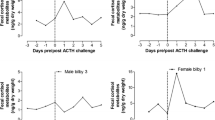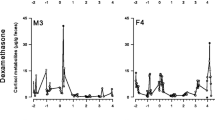Abstract
This longitudinal study addresses the relationship of different husbandry systems to fecal cortisol metabolites (FCM) concentrations in captive brown brocket deer and marsh deer in order to ascertain a less stressful captive condition for these species. Thus, three pairs from both species were submitted to three different husbandry systems (10 days per system), and fecal samples were collected in the last 5 days of each management. A cortisol enzyme immunoassay was validated and used to measure FCM. The physiological significance of these measurements was verified in brown brocket deer by an adrenocorticotropic hormone challenge test, which induced a fourfold (above baseline) increase of FCM within 24 to 28 h. In marsh deer, wild-capture individuals (2,802 ± 115 ng/g) had significantly higher concentrations (P < 0.05) than captive-born ones (122 ± 32 ng/g). Higher values of FCM (P < 0.05) were measured in brown brocket deer kept as pairs in outdoor exhibits all day (150 ± 15 ng/g) compared to animals kept integrally in individual stalls (71 ± 7 ng/g) or in outdoor exhibits during daytime and individual stalls during nighttime (78 ± 4 ng/g). In contrast, no differences in FCM were found in marsh deer submitted to any husbandry system (P > 0.05). These findings suggest that brown brocket deer may benefit from husbandry systems, which keep animals at least for one period in individual stalls, while marsh deer apparently exhibit a high individual variability to different husbandry conditions with no generic pattern to its better maintenance in captivity.



Similar content being viewed by others
References
Barnett JL, Hemsworth PH (1990) The validity of physiological and behavioural measures of animal welfare. Appl Anim Behav Sci 25:177–187
Black-Décima P (2000) Home range, social structure, and scent marking behavior in brown brocket deer (Mazama gouazoubira) in a large enclosure. J Neotrop Mammal 7:5–14
Blanvillain C, Berthier JL, Bomsel-Demontoy MC, Sempèrè AJ, Olbricht G, Schwarzenberger F (1997) Analysis of reproductive data and measurement of fecal progesterone metabolites to monitor the ovarian function in the pudu, Pudu puda (Artiodactyla, Cervidae). Mammalia 61:589–602
Bubenik GA, Schams D, White RG, Rowell J, Black J, Bartos L (1998) Seasonal levels of metabolic hormones and substrates in male and female reindeer (Rangifer tarandus). Comp Biochem Phys C 120:307–315
Carlstead K, Brown JL, Seidensticker J (1993) Behavioral and adrenocortical responses to environmental changes in leopard cats (Felis bengalensis). Zoo Biol 12:321–331
Carragher JF, Ingram JR, Matthews LR (1997) Effects of yarding and handling procedures on stress responses of red deer stags (Cervus elaphus). Appl Anim Behav Sci 51:143–158
Cook RC, Cook JG, Garrot RA, Irwin LL, Monfort SL (2002) Effects of diet and body condition on fecal progestagen excretion in elk. J Wildlife Dis 38:558–565
Dehnhard M, Clauss M, Lechner-Doll M, Meyer HH, Palme R (2001) Noninvasive monitoring of adrenocortical activity in roe deer (Capreolus capreolus) by measurement of fecal cortisol metabolites. Gen Comp Endocr 123:111–120
Dobson H, Smith RF (1995) Stress and reproduction in farm animals. J Reprod Fert - Supplement 49:451–461
Duarte JMB, Merino ML, Gonzalez S, Nunes ALV, Garcia JM, Szabó MPJ, Pandolfi JR, Arantes IG, Nascimento AA, Machado RZ, Araujo JP Jr, Catao-Dias JL, Werther K, Garcia JE, Girio RJS, Matushima ER (2001) Order Artiodactla, Family Cervidae (Deer). In: Fowler ME, Cubas ZS (eds) Biology, medicine, and sugery of south american wild animals. Iowa State University Press, Ames, pp 402–422, 536 p
Hamasaki S, Yamauchi K, Ohki T, Murakami M, Takahara Y, Takeuchi Y, Mori Y (2001) Comparison of various reproductive status in sika deer (Cervus nippon) using fecal steroid analysis. J Vet Med Sci 63:195–198
Hamilton WJ (1994) Portable handling facilities to improve the welfare of farmed red deer (Cervus elaphus). Anim Welfare 3:227–233
Hanlon AJ, Rhind SM, Reid HW, Burrels C, Lawrence AB, Milne JA, McMillen SR (1994) Relationship between immune response, liveweight gain, behaviour and adrenal function in red deer (Cervus elpahus) calves derived from wild and farmed stock, maintained at two housing densities. Appl Anim Behav Sci 41:243–255
Haulton SM, Porter WF, Rudolph BA (2001) Evaluating 4 methods to capture white-tailed deer. Wildl Soc Bull 29:255–264
Huber S, Palme R, Arnold W (2003a) Effects of season, sex, and sample collection on concentrations of fecal cortisol metabolites in red deer (Cervus elaphus). Gen Comp Endocr 130:48–54
Huber S, Palme R, Zenker W, Mostl E (2003b) Non-invasive monitoring of the adrenocortical response in red deer. J Wildlife Manage 67:258–266
IUCN (2009) IUCN Red List of Threatened Species. Version 2009.2. (www.iucnredlist.org). Downloaded on 18 Nov 2009
Kapke CA, Arcese P, Ziegler TE, Scheffler GR (1999) Estradiol and progesterone metabolite concentration in white-tailed deer (Odocoileus virginianus) feces. J Zoo Wildlife Med 30:361–371
Keay JM, Singh J, Gaunt MC, Kaur T (2006) Fecal glucocorticoids and their metabolites as indicators of stress in various mammalian species: a literature review. J Zoo Wildlife Med 37:234–244
Kim JJ, Diamond DM (2002) The stressed hippocampus, synaptic plasticity and lost memory. Nat Rev Neurosci 3:453–462
Kleiman DG (1996) Reintroduction programs. In: Kleiman DG, Allen ME, Thompson KV, Lumpkin S (eds) Wild mammals in captivity. The University of Chicago Press, Chicago, pp 297–305
Li C, Jiang Z, Jiang G, Fang J (2001) Seasonal changes of reproductive behavior and fecal steroid concentrations in Père David’s deer. Horm Behav 40:518–525
Li C, Jiang Z, Zeng Y, You Z (2005) Rutting tatics in Père David’s deer stags under different population densities and during different rut periods. Biodiv Sci 13:424–431
Li C, Jiang Z, Tang S, Zeng Y (2007) Influence of enclosure size and animal density on fecal cortisol concentration and aggression in Père David’s deer stags. Gen Comp Endocr 151:202–209
Liu J, Chen Y, Guo L, Gu B, Liu H, Hou A, Liu X, Sun L, Liu D (2006) Stereotypic behavior and fecal cortisol level in captive giant pandas in relation to environmental enrichment. Zoo Biol 25:445–459
Mamone AP (2001) Etograma do cervo-do-pantanal (Blastocerus dichotomus) em cativeiro, com ênfase nas interações sociais e estados de vigilância, alerta e fuga. (thesis). Faculdade de Ciências Agrárias e Veterinárias, Universidade Estadual Paulista, Jaboticabal
Maple TL, Perkins LA (1996) Enclosure furnishings and structural environmental enrichment. In: Kleiman DG, Allen ME, Thompson KV, Lumpkin S (eds) Wild mammals in captivity. The University of Chicago Press, Chicago, pp 212–222
Mason GJ, Latham NR (2004) Can’t stop, won’t stop: is stereotypy a reliable animal welfare indicator? Anim Welf 13:57–69
Millspaugh JJ, Washburn BE (2004) Use of fecal glucocorticoid metabolite measures in conservation biology research: considerations for application and interpretation. Gen Comp Endocr 138:189–199
Millspaugh JJ, Woods RJ, Hunt KE, Raedeke KJ, Brundige GC, Washburn BE, Wasser SK (2001) Fecal glucocorticoid assays and the physiological stress response in elk. Wildlife Soc B 29:899–907
Millspaugh JJ, Washburn BE, Milanick MA, Beringer J, Hausen LP, Meyer TM (2002) Non-invasive techniques for stress assessment in white-tailed deer. Wildlife Soc B 30:899–907
Morton DJ, Anderson E, Foggin CM, Kock MD, Tiran EP (1995) Plasma cortisol as an indicator of stress due to capture and translocation in wildlife species. Vet Rec 136:60–63
Möstl E, Palme R (2002) Hormone as indicators of stress. Domest Anim Endocrinol 27:67–74
Möstl E, Maggs JL, Schrötter G, Besenfelder U, Palme R (2002) Measurement of cortisol metabolites in faeces of ruminants. Vet Res Commun 26:127–139
Nelson RJ (2005) Stress. In: Nelson RJ (ed) An introduction to behavioral endocrinology, 3rd edn. Sinauer Associates, Inc., Sunderland, pp 668–720
Palme R (2005) Measuring fecal steroids: guidelines for practical application. Ann NY Acad Sci 1046:75–80
Palme R, Fischer P, Schildorfer H, Ismail MN (1996) Excretion of infused 14C-steroid hormones via faeces and urine in domestic livestock. Anim Reprod Sci 43:43–63
Palme R, Robia C, Messmann S, Hofer J, Möstl E (1999) Measurement of feacal cortisol metabolites in ruminants: a non-invasive parameter of adrenocortical function. Wien Tierärztl Mschr 86:237–241
Pereira RJG, Negrão JA, Duarte JMB (2005) Seasonal changes in fecal testosterone concentrations and their relationship to the reproductive behavior, antler cycle and grouping patterns in free-ranging male Pampas deer (Ozotoceros bezoarticus bezoarticus). Theriogenology 63:2112–2125
Pereira RJG, Duarte JMB, Negrão JA (2006a) Effects of environmental conditions, human activity, reproduction, antler cycle and grouping on fecal glucocorticods of free-ranging Pampas deer stags (Ozotoceros bezoarticus bezoarticus). Horm Behav 49:114–122
Pereira RJG, Polegato BF, Souza S, Negrão JA, Duarte JMB (2006b) Monitoring ovarian cycles and pregnancy in brown brocket deer (Mazama gouazoubira) by measurement of fecal progesterone metabolites. Theriogenology 65:387–399
Pollard JC, Littlejohn RP (1996) The effects of pen size on the behaviour of farmed red deer stags confined in yards. Appl Anim Behav Sci 47:247–253
Ramos HGC (2004) O ciclo do chifre do cervo do pantanal: aspectos ecológicos e reprodutivos. (thesis). Faculdade de Ciências Agrárias e Veterinárias, Universidade Estadual Paulista, Jaboticabal
Ryder OA, Fleischer RC (1996) Genetic Research and its application in zoos. In: Kleiman DG, Allen ME, Thompsom KV, Lumpkin S (eds) Wild mammals in captivity. The University of Chicago Press, Chicago, pp 255–262
Schaller GB, Vasconcelos JMC (1978) A marsh deer census in Brazil. Oryx 14:345–351
Schwarzenberger F, Möstl E, Palme R, Bamberg E (1996) Faecal steroid analysis for non-invasive monitoring of reproductive status in farm, wild and zoo animals. Anim Reprod Sci 42:515–526
Seidensticker J, Doherty JG (1996) Integrating animal behavior and exhibit design. In: Kleiman DG, Allen ME, Thompson KV, Lumpkin S (eds) Wild mammals in captivity. The University of Chicago Press, Chicago, pp 180–190
Stallings JR (1986) Notes on the reproductive biology of grey brocket deer (Mazama gouazoubira) in Paraguay. J Mammal 67:172–175
Stoops MA, Anderson GB, Lasley B, Shideler SE (1999) Use of fecal steroid metabolites to estimate the pregnancy rate of a free-ranging herd of tule elk. J Wildlife Manage 63:561–569
Touma C, Palme R (2005) Measuring fecal glucocorticoid metabolites in mammals and birds: the importance of validation. Ann NY Acad Sci 1046:54–74
Versiani NF, Pereira RJG, Duarte JMB (2009) Annual variations in fecal androgen metabolites and antler cycle of captive red brocket bucks (Mazama americana) in southeast Brazil. Eur J Wildlife Res 55:535–538
Washburn BE, Millspaugh JJ (2002) Effects of simulated environmental conditions on glucocorticoid metabolite measurements in white-tailed deer feces. Gen Comp Endocr 127:217–222
Wasser SK, Hunt KE, Brown JL, Cooper K, Crockett CM, Bechert U, Millspaugh JJ, Larson S, Monfort SL (2000) A generalized fecal glucocorticoid assay for use in a diverse array of nondomestic mammalian and avian species. Gen Comp Endocr 120:260–275
Wells A, Terio KA, Ziccardi MH, Munson L (2004) The stress response to environmental change in captive cheetahs (Acinonyx jubatus). J Zoo Wildlife Med 35:8–14
Wielebnowski NC, Fletchall N, Carlstead K, Busso JM, Brown JL (2002) Noninvasive assessment of adrenal activity associated with husbandry and behavioral factors in the North American clouded leopard population. Zoo Biol 21:77–88
Young KM, Walker SL, Lanthier C, Waddell WT, Monfort SL, Brown JL (2004) Noninvasive monitoring of adrenocortical activity in carnivores by fecal glucocorticoid analyses. Gen Comp Endocr 137:148–165
Acknowledgements
This research was funded by CAPES, CNPq, and FAPESP. Special thanks to NUPECCE/UNESP staff and Conservationist Breeder “Rancho das Hortênsias” for their assistance with the animals and sample collection. We are also grateful to G. T. Pereira for his statistical support and Prof. Gabriel Maurício Peruca de Melo for his assistance in sample processing.
Author information
Authors and Affiliations
Corresponding author
Additional information
Communicated by H. Kierdorf
Rights and permissions
About this article
Cite this article
Christofoletti, M.D., Pereira, R.J.G. & Duarte, J.M.B. Influence of husbandry systems on physiological stress reactions of captive brown brocket (Mazama gouazoubira) and marsh deer (Blastocerus dichotomus)—noninvasive analysis of fecal cortisol metabolites. Eur J Wildl Res 56, 561–568 (2010). https://doi.org/10.1007/s10344-009-0350-8
Received:
Revised:
Accepted:
Published:
Issue Date:
DOI: https://doi.org/10.1007/s10344-009-0350-8




